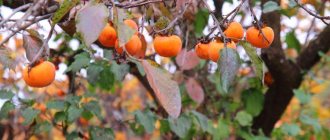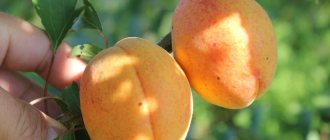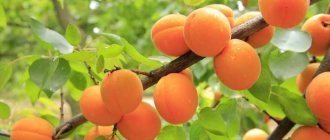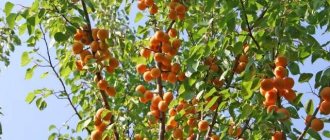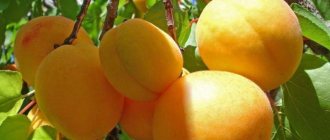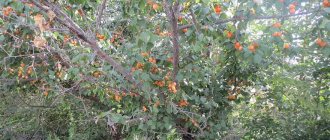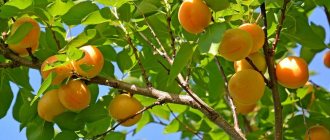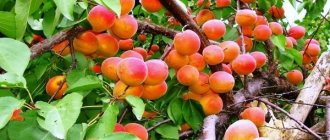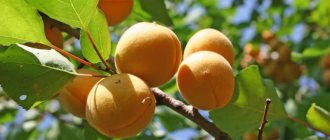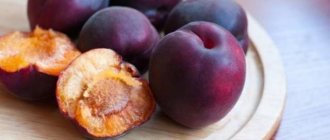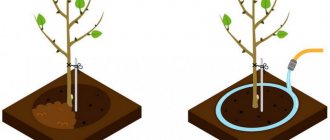Red-cheeked apricot is an old and proven variety, loved by gardeners for its successful combination of taste and beauty of the fruit. The variety became the ancestor of many modern hybrids, capable of growing in harsher conditions than their “ancestor”. Let's learn about the features of planting and growing “red-cheeked” apricots.
apricot variety "Red-cheeked"
the “Red-cheeked” variety is popular due to its high consumer qualities
apricot “Red-cheeked” - southern, heat-loving variety
How did the Red-cheeked apricot appear?
Accurate information about the origin of the variety has not been preserved. It is only known that the first apricots with characteristic red dots merging into a “blush” grew in, apricots with “ruddy” fruits came to Armenia, and from there they spread to the southern regions of Russia.
Crimean breeders managed to consolidate a characteristic feature - red spot spotting. After selection work carried out in the Nikitsky Botanical Garden (Crimea), the Krasnoshcheky variety was officially included in the State Register in 1947.
Description of the apricot variety Red-cheeked
The tree of the described apricot variety has a spreading crown. Refers to tall growing trees. The height can reach 4 meters. Thanks to the timely and correct formation of the crown, you can get a low spreading tree. The variety took its name from the red-cheeked color of ripe fruits.
Fruit characteristics:
- weight of one apricot - 50 grams;
- the shape of the fruit is often round;
- the pulp is quite soft, juicy and porous;
- the taste is dominated by sweet and sour notes;
- the seed is easily separated from the fruit;
- It begins to bear fruit at 3-4 years.
The variety is a long-lived tree; the ability to bear fruit lasts up to 50 years. Caring for such a tree is a pleasure for gardeners.
History of selection
There is very little information about the apricot's homeland and origin. It is known that red-cheeked fruits were first noticed in the mountains of Central Asia. Later, the variety began to be grown in Armenia. And only in the post-war period the Crimean breeders of the Nikitsky Botanical Garden gave it a new life. Many red-cheeked hybrids have been bred on its basis.
Today this variety is considered competitive among apricots of European origin. Due to its unpretentiousness, the breeders made sure that the tree felt comfortable regardless of the region. Selection has made it possible to expand the growing area of the red-cheeked apricot.
Advantages and disadvantages
- Apricot fruiting is not long in coming; already in the 3rd year you can taste the first fruits from the tree.
- The variety does not require additional pollination and the presence of other apricots nearby.
- Late flowering avoids the harmful effects of spring frosts.
- The tree grows well and bears fruit in any type of soil.
- Red-cheeked apricot has increased frost resistance. Not afraid of drought.
- Despite its resistance to diseases, it is susceptible to some infections.
- Does not like excessive moisture; fogs and rains contribute to the development of moniliosis.
- It bears fruit worse in lowlands and on wet soils. In winter, in such soil, young shoots can be damaged by frost.
Characteristics of trees and fruits
The crown of the tree is powerful, the branches are spreading and strong. The plant is not afraid of strong winds. The variety has earned particular popularity due to its high yield. From one tree you can collect 10 buckets of apricot. Seedlings, to a greater extent, take root easily and can withstand low temperatures. There are no special requirements for planting young shoots. Thanks to the thick bark, the crown is protected from damage. The tree loves a lot of light.
Grows well in open areas. Being a hardy variety, it tolerates the conditions of the “Russian winter”. Such trees will become a worthy decoration of any garden. Ripe apricots have a golden-orange color. A distinctive feature from other varieties is the red barrels. The skin of the fruit is dense and velvety to the touch. The aroma of fruit when broken is pronounced.
The fruits ripen in the second half of July. Due to uneven ripening, harvesting must be carried out in several stages. This approach will prevent the apricots from falling off. The variety tolerates transportation well. Ripe fruits are in demand for resale in markets. After harvesting, the fruits can be stored for up to 10 days.
Region of growth and adaptation in other regions
The variety and its hybrids have proven themselves well in the northern part of the Southern zone and the South-Western regions. In Ukraine, Belarus, Latvia, Crimea, the North Caucasus and the Volga region. The unpretentiousness of apricot allows you to see this variety in garden plots in many parts of Russia. It is widespread in Rostov-on-Don and Krasnodar. The geography of cultivation is too rich to list all the regions. In the South, the red-cheeked miracle can be found in almost every yard.
Yield and storage
Productivity depends on the care of the seedling from the moment of planting to fruiting. If the recommendations of experienced gardeners are followed, the result will certainly please you. The harvest volume can be increased if the fruits are collected in 3-4 stages. The remaining fruits on the tree fill up and increase in volume after each harvest. This technique will solve the storage problem; fruits can wait in the wings on the tree for up to 3 weeks.
Depending on further use, fruits of different ripeness are picked. Overripe apricots are suitable for drying; moderately ripe ones without damage are suitable for food. If it is proposed to transport fruits over long distances for the purpose of selling them in markets, it is necessary to collect fruits that are slightly ripe and light yellow in color. Any apricots are suitable for canning. A practical housewife will find a worthy use for them.
Description of the tree and fruits
An experienced gardener can easily distinguish Red-cheeked by the characteristics characteristic of this variety:
- Tree. Powerful, tall, reaching a height of 12 m. The crown is sparse and spreading. The branches are long.
- Fruits . The red-cheeked apricot is easily recognizable by its beautiful orange-red fruits. The shape of the fruit is round, ovoid. There is a deep abdominal suture. The fruits are covered with a velvety skin, thin but dense. Color – golden orange. The surface is covered with red dots, sometimes merging into spots. Weight – 40-65 g. The seeds are large, easily separated from the pulp, their weight is 6.5% of the weight of the fruit. Inside the seeds are tasty kernels.
Red-cheeked fruits are sweet and sour. The light orange pulp has a pleasant apricot aroma. Fruit composition:
- sugar – 9.7%;
- dry matter – 13.7%;
- acids – 1.37%;
- ascorbic acid – 13.7 mg per 100 g.
Apricot calorie content is 41-44 kcal per 100 g. The fruit contains: proteins - 0.9 g, carbohydrates - 10.8 g, fats - 0.1 g.
Reviews from gardeners
Red-cheeked is a vigorous tree with a rounded, spreading crown. The fruits are medium-sized (40–52 g), rounded-flat, ovoid, golden-orange with a blurred red blush. The skin is velvety-pubescent, rather thin, but dense. The pulp is light orange, with a sweet and sour characteristic apricot aroma. The bone is well separated from the pulp. The variety is early-bearing (3–4 years), fruiting July 20–23. Productivity is annual.
Voloshun Ivan
https://forum.vinograd.info/showthread.php?t=11246
Red-cheeked - weak in winter hardiness for the Moscow region.
Sadovnik62
https://www.forumhouse.ru/threads/1322/page-38#post-12108834
I have several trees. Two are from seed, and one is grafted, the Red-cheeked variety. Those from seeds are unpretentious and their fruits are large, oddly enough. One problem is that on one tree the apricot pits cannot be separated from the pulp. But the second one doesn’t have such a problem - it bounces right back! The grafted one will freeze, then aphids will attack him, or something else will happen. Very tasty and very beautiful, large, sweet! But not enough.
Elol
https://indasad.ru/forum/2-plodoviy-sad/2150-vyrashchivanie-abrikosa?start=10
I’m not a scientist or even a gardener, but just a beginner amateur. I have only one apricot growing. Variety - Red-cheeked. I note that the neighbors nearby don’t have them either. Apricot is 4 years old. For the past 2 years we have been collecting a very decent harvest.
temernik
https://www.forumhouse.ru/threads/1322/page-5
Red-cheeked apricot is a variety that ideally combines enviable yields, excellent fruit quality and unpretentious cultivation. It is successfully cultivated in different climatic conditions - it tolerates drought, wind, and frost well. Red-cheeked will be a worthy choice for growing in our gardens.
- Author: Anatoly Gutsol
Hello! My name is Anatoliy. I am 46 years old and a mining engineer by profession. Married, I have two children. Rate this article:
- 5
- 4
- 3
- 2
- 1
(0 votes, average: 0 out of 5)
Share with your friends!
Main characteristics of Red-cheeked apricot
Producing half a centner of fruits per year, the variety does not require special agrotechnical measures. The variety takes root without problems and easily tolerates lack of watering.
Red-cheeked is valued for its excellent agrotechnical characteristics:
- Drought resistance. Possessing a powerful, well-developed root system, the tree extracts water from the depths without needing external moisture.
- Frost resistance. The variety is reliable only in those regions for which it is intended. Red-cheeked can withstand frosts down to minus 15-20 degrees without damage. But the shorter the periods of low temperatures, the better.
- Resistance to diseases and pests. Most of all, Red-cheeked is afraid of fungal diseases; it can be affected by moniliosis, clusterosporiasis and brown spot. If the weather is unfavorable - damp, little sun and cool, then the tree will inevitably become infected with some kind of fungus.
- Self-fertility. The variety does not require additional pollinating varieties. You can plant only one apricot tree on a plot, and it will bear full fruit.
Main agrotechnical characteristics of Red-cheeked apricot:
| Characteristics | Parameters/description |
| Productivity | 70 kg per tree |
| Ripening time | end of June |
| Precociousness | high |
| Pollination | self-fertile |
| Frost resistance | average |
| Immunity | average |
| Lifespan | 50-60 years |
| Drought resistance | high |
Characteristics of the variety
Description of the plant
Red-cheeked apricot is a tall tree with a spreading crown and long branches. Its height reaches 4 m. But it is better to form the crown so that the height does not exceed 3 m. This makes caring for the plant and harvesting easier.
The lifespan of this apricot tree is about 50 years.
Description of fruits
Large and “ruddy” fruits have an oval or round shape
The fruits have a round or oval (sometimes heart-shaped) shape and are medium in size. Their weight is 40–60 g. A special feature is the rather deep seam on the abdomen. The ripe fruit is colored bright yellow-orange with a red “blush”. This characteristic feature served as the basis for the name of the variety.
Juicy, tasty pulp is easily separated from the seed
The pulp is light, sweet (with a pleasant sour tint), juicy and tender. It is easily and without damage separated from the bone.
Ripening and harvesting
Red-cheeked apricot begins to ripen in mid-July. This process can take a long time, especially with a bountiful harvest. Therefore, it is advisable to collect fruits periodically, 2–3 times during the summer. This way, the period of enjoying fresh apricots is extended and the problem of storing them is partially solved. Considering that fully ripe fruits quickly crumble and spoil, it is better to pick them when they are greenish. Such fruits can be stored for 10–14 days.
Usage
Red-cheeked apricots are great for making preserves and jams
Red-cheeked fruits delight with their versatility. They have excellent taste and contain many vitamins and minerals. Suitable for both fresh consumption and for preparing compotes, preserves and jams, and storing as dried fruits.
Advantages and disadvantages of the variety
The popularity of Red-cheeked among summer residents and gardeners is well deserved, because the variety has many advantages. However, apricot is not without some disadvantages.
| Advantages | Flaws |
| high yield – 90–100 kg per tree | susceptibility to blight and moniliosis infections (causes: rainy or foggy weather and thickening of the crown) |
| speed of fruiting (the first harvest can be obtained 3–4 years after planting) | need for plenty of light and warmth |
| self-fertility (does not require the presence of pollinators for ovary formation) | |
| late flowering (spring frosts do not affect yield) | |
| unpretentiousness to soil (develops well on any type of soil, does not require fertility) | |
| increased frost and drought resistance | |
| resistance to most diseases |
Obviously, there are significantly fewer disadvantages. In addition, the specific “needs” of this variety can be easily satisfied with proper care.
Pros and cons of the variety
Advantages due to which the Red-cheeked variety remains popular among gardeners:
- Early fruiting - the tree produces its first harvest in the third year after planting.
- Self-fertility - produces large yields in the absence of pollinators.
- Resists well against many diseases and pests. You don't have to spray the tree a lot.
- High yield. A large tree and an abundance of large fruits are the ideal combination for large harvests.
- Resistance to extreme growing conditions. Tolerates low winter temperatures and summer drought.
- Excellent taste and commercial quality of the fruit. This is a good commercial variety.
- The versatility of the fruit is suitable for any purpose.
- Unpretentious and undemanding to soils.
- Decorative. The tree is powerful and beautiful. Especially during the flowering period, when it is decorated with numerous flowers, and during fruiting, when the branches are strewn with red-sided fruits.
Apricot flowering lasts about 10 days. The tree, covered with delicately fragrant flowers, attracts numerous honey plants.
Red-cheeked has few disadvantages:
- A tall tree is difficult to maintain - it makes spraying and harvesting difficult.
- Does not tolerate temperature changes and frosts well. Because of them, flower buds die. When frozen, it takes a very long time and is difficult to recover.
The most dangerous time for the Red-cheeked variety is the alternation of spring thaw with frost.
Advantages and disadvantages
The red-cheeked one pleases with its precociousness, but does not tolerate frosts
The advantages of this variety of apricot include the following aspects:
- resistance to drought and low temperatures;
- self-fertility;
- ability to resist diseases;
- precociousness;
- high productivity;
- undemanding to soil;
- high taste qualities.
The disadvantage of the culture is its sensitivity to sudden temperature changes. The most dangerous period for red-cheeked apricot is spring, when thaw alternates with frost. Such fluctuations negatively affect flower buds, which can even die from unstable temperatures.
Fruiting and productivity
Red-cheeked is a mid-season variety. Fruiting begins in 3-5 years, and depends on specific climatic conditions. In most regions of Russia, fruits ripen in the range of mid-July to early August.
The harvest is annual, there are no breaks in fruiting. Except in cases of freezing of flower buds. Productive fruiting lasts 50-60 years.
Productivity of the Red-cheeked variety:
- From one tree – 60 kg. There are records of 80-90 kg. 50-60 kg is 10-15 buckets of apricots.
- From 1 ha – 65 centners, maximum – 180 centners.
Care
The subtleties of growing boil down to performing the following work.
The variety is drought-resistant, but in the first years after rooting, the young tree will require regular moisture for normal development of the root system. An adult crop is watered 3 times during the season - during flowering, crop ripening and before wintering. The seedling will need to be moistened as the soil in the tree trunk dries.
In the first 3 years after planting, there will be no need to feed the apricot. In subsequent seasons, you will need to fertilize the tree with humus or compost once every 4 years. During the fruiting period, ammonium nitrate is used - 30 g/m2, potassium monophosphate - 15 g/m2. In autumn, when digging, it is recommended to add superphosphate - 20 g/m2.
Regular pruning will normalize tree growth and reduce the load from the first harvests, which will have a positive effect on rooting. Sanitary haircuts are carried out every spring and autumn. At this time, non-viable branches must be removed.
In the first year, the thickest branches are shortened by half, while the length of the conductor should be 20-30 cm longer. In the second year, 2-3 more branches are selected and trimmed. In the third year, the branches of the third row are shortened. In this case, the central conductor is cut off completely.
Anti-aging pruning is carried out every 3-4 years. It will be possible to stimulate the tree to form new branches by pruning 2-4 shoots to 20-30 cm in length. To establish fruiting inside the crown, in the spring you will need to expose the skeletal branches.
After cutting, the cut areas are treated with copper or iron sulfate, as well as garden pitch.
It is recommended to collect fruits in dry weather in the morning or evening to preserve their organoleptic qualities. It is best to pick unripe fruits that reach ripeness indoors or during transportation.
The trunk circle is covered with a layer of mulch, the trunk is treated with whitewash with copper sulfate, the shoots of the young seedling are tied up and covered with a cardboard box with sawdust or paper. In the northern regions, they build a frame and cover it with spunbond or burlap.
Popular types of apricot varieties Red-cheeked
After the official registration of Red-cheeked, work began to improve its characteristics by creating hybrids. The work of breeders brought excellent results; based on the popular variety, many varieties were created with new characteristics and capabilities.
Distinctive features of popular species of Red-cheeked:
| Name | Distinctive features |
| Red-cheeked Nikitsky | It differs from its ancestor in the flattened shape of the fruit, sweeter and more tender pulp. |
| Red-cheeked late | It ripens later than Red-cheeked - in late July-early August. |
| Red-cheeked son | It has improved winter hardiness and can withstand temperature changes better. More Red-cheeked is suitable for the middle zone. |
| Red-cheeked Salgirsky | It is characterized by increased productivity and good technical properties of the fruit. |
| Hardy | Tolerates harsh climates well. The branches safely withstand cold winters. The fruits have a flattened shape, and the skin is darker than that of Red-cheeked. |
| Russian | Low growing tree. Suitable for growing in the middle zone. Withstands severe frosts. |
| Bullfinch | The hardiest species of Red-cheeked. The tree is very compact - only 1.5 in height. Productivity – 10 kg per tree. The fruits are dense and can be stored for a long time. |
Planting and care
Fruit trees require plenty of light to grow.
Plant the Red-cheeked apricot on a hill so that melt water in the spring does not wash away the roots. Make sure that there is plenty of free space around the tree, and that buildings and large plants do not cast a shadow on the seedling. There are no special requirements for the soil, however, if increased acidity is observed, add lime to the soil.
Dig a hole a little more than half a meter in diameter and depth. Mix the soil with organic fertilizers. There is no need to dig the seedling in hard, just bury it so that the rhizome is covered. Compact the circle around the trunk with your feet, this way you will compact the soil around the roots. Then add mulch to slow weed growth.
The most favorable time for planting is the second half of spring or mid-autumn. Red-cheeked is a self-fertile apricot variety, so the description of the planting process does not include the mandatory planting of pollinators. However, experience shows that the yield of a tree will be higher if several more of the same tree grow on the site.
For better drainage, place gravel at the bottom of the hole.
In addition to a seedling, you can plant a seed; it can also be used to grow an adult tree. The process is simple and consists of just a few steps:
- select overripe large fruits;
- fill the box with wet sand and dig the seeds into it (carry out the procedure at the end of January);
- place the box in frozen ground or in the refrigerator until spring;
- in April, plant them in prepared soil in the same way as seedlings.
There is another way to plant seeds in the second half of summer. It's called "from the mouth." Immediately dig a seed from a freshly picked fruit shallow into the ground and wait for it to emerge.
The Red-cheeked apricot does not need constant care, but basic manipulations will have to be performed. The variety requires abundant watering, although it has good drought resistance. Make sure that the soil is well moistened after planting and during vigorous growth, but at least 4 times per season:
- during flowering;
- in May;
- at the beginning of July;
- In November.
Remember to trim branches regularly in spring, summer and fall. This will increase yield and reduce the likelihood of disease. Fruit rot and spotting can often affect apricots, so treat with Bordeaux mixture in the spring.
The tree needs to be insulated for the winter.
Wrap the stem in burlap and drive stakes around it. Then wrap them in film, creating a kind of cocoon around the plant that will protect it from the piercing wind and frost. The description of the Red-cheeked apricot variety indicates that it is excellent for planting throughout Russia. Frost resistance allows it to be grown in cold regions, and resistance to drought prevents the plant from dying in hot climates. It is the undemanding nature of the soil and resistance to many diseases that have made this type of apricot so popular among professional gardeners.
You can grow fruits both for your own consumption and for sale. The fruits do not lose their taste during transportation for a long time, so there will be no problems with this.
Secrets of growing apricots - video
https://fruktik.guru/abrikos/abrikos-sorta-krasnoshhekiy-opisanie.html
https://legkovmeste.ru/sad/abrikos-krasnoshhyokiy-kak-vyirashhivat-sladkiy-frukt.html
https://glav-dacha.ru/abrikos-sorta-krasnoshhekiy/
Landing rules
The entire future fate of the tree depends on how accurate the gardener’s actions are during planting. We will learn how to prepare for planting a seedling and how to do it correctly.
Optimal timing
The exact planting dates depend on the climatic conditions of the region. Two landing options are practiced:
- Autumn. More suitable for southern regions. Milder and later winters allow seedlings to take root safely and survive a difficult period without loss. About one and a half months should pass between planting and the onset of stable frosts.
- Spring. This option is suitable for regions with cold winters. Planting begins as soon as the snow melts, before the sap begins to flow.
In the middle zone, as in the southern regions, apricot seedlings can be planted both in spring and autumn. If weather forecasters predict an early winter, it is better to postpone planting until spring.
Choosing the best place
Requirements for a site for planting apricots:
- Relief. Plain or hilly terrain is suitable. Lowlands with stagnant moisture are not suitable. It is advisable that the site be protected from strong winds. A barrier can be a wall, a high fence, or a planting.
- Illumination. Apricot is light-loving, so choose a sunny area for planting.
- Ground water level. The occurrence of groundwater should be no closer than 2.5 m from the surface.
- The soil. Light loamy, loamy and low-carbonate soils with a neutral or slightly alkaline reaction are suitable. The pH level is from 7 to 8. Soils with a high lime content are not suitable, but in overly acidic soils, on the contrary, it should be added.
The main thing that apricots don’t like:
- Shadow. Light deficiency negatively affects the growth and development of a tree and reduces its yield.
- Moisture. High humidity has a detrimental effect on the root system - it damps out, and then the tree itself dies.
Cultural neighborhood
Apricot doesn't like neighbors. It is adversely affected by the proximity of any stone fruit crops. Apricots are not planted near apple trees, plums, pears, cherries, cherries, nuts, rowan berries - they all have a suppressive effect on the crop. Experienced gardeners recommend that when planting apricot seedlings, keep a distance of 10 m from the nearest plantings.
In addition to fruit trees, apricots are also badly affected by berry bushes - raspberries and currants. Pests that parasitize these crops, moving to the apricot tree, weaken it and reduce productivity. The best option is to plant flowers or low vegetables near the apricot. But only those that have an underdeveloped root system - so that it does not damage the roots of the tree.
Selection and preparation of planting material
When buying a seedling, it is impossible to predict how strong and healthy it is, so when choosing you have to focus on external signs:
- Bark. There should be no damage, cracks, spots or other marks on the trunk and branches that indicate disease or weakness of the seedling.
- Roots . The root system is moderate in size, but strong. Seedlings with weak and thin roots are not suitable - they will take a long time and have difficulty taking root.
- Height . The optimal option is 70-80 cm.
- Age . It is advisable to purchase an annual seedling.
- Type of seedling. It is recommended to buy a grafted seedling rather than a seedling. Grafted seedlings are carriers of parental properties, and seedlings are often unpredictable - they can surpass their parents in fruit quality and yield, or they can grow wild. Seedlings of cultivated varieties do not have thorns, but there are stumps at the root - the place where the rootstock is cut above the established bud.
Experienced gardeners practice growing apricots from seeds. Such trees are not only not inferior to ordinary seedlings, but also superior in yield.
The root system of a purchased seedling should not dry out during transportation. To restore the seedling's ability to grow, its roots are placed in water a day or two before planting. You can add potassium permanganate (at the tip of a knife) or a bio-fungicide to it. The roots are trimmed with a sharp, disinfected knife, removing damaged and dead tissue. Immediately before planting, the roots are dipped into a mash of clay and mullein.
Pit preparation
The holes for planting, regardless of the time of planting (autumn/spring), are prepared in advance. This is necessary for soil shrinkage. If the seedling is planted in the fall, then the pit is prepared two weeks before planting, and if in the spring, then the soil and pits are prepared in the fall, in October or November.
Red-cheeked has a powerful root system, so a hole is dug at least 80 cm deep. The diameter is 50-60 cm. Drainage is made at the bottom of the hole to prevent moisture stagnation near the roots. Expanded clay is most suitable for drainage, but you can also add pebbles, crushed stone, brick chips, and clay shards.
The procedure for preparing the pit:
- The fertile layer - 15-20 cm - is set aside.
- Mix fertile soil with humus/compost (1.5-2 buckets).
- Fertilizers are added to the soil mixture - nitrogen (30-40 g), phosphorus (60-70 g), potassium (25-30 g). You can use complex fertilizer, for example, Azofoska or Nitrophoska (120-150 g). Adherents of natural fertilizers can add 3 liters of wood ash.
- The mixture is poured into the hole, filling it 2/3, then covered with waterproof material.
Step-by-step guide to planting
Step-by-step instructions for planting an apricot seedling:
- Open the planting hole by removing the waterproof covering. A support for the seedling is installed a little away from the center of the mound of soil mixture. The peg should be approximately 20-30 cm higher than the tree.
- 30-40 liters of water are poured into the pit.
- The seedling prepared for planting is immersed on a mound so that the roots are evenly distributed on it. There should be no protruding roots.
- The roots are covered with the prepared substrate, carefully compacted so that there are no air gaps. For the same purpose, the tree is periodically shaken. When the hole is filled, the root collar should be no less than 4-5 cm from the soil surface. If apricot is planted in a sandy substrate, the distance is reduced to 3-4 cm.
- Having compacted the soil, at a distance of 50 cm from the trunk, around the circumference, they make a small earthen bank so that water does not spill out.
- Water the seedling with 2-3 buckets of water.
- Half an hour later, when the water is absorbed, the tree trunk circle is sprinkled with mulch. Peat chips, fallen leaves, freshly cut grass or humus are suitable for this purpose.
- The tree is carefully tied to a support.
- The side branches are cut off completely, the main conductor - by 1/3.
Proper landing
To ensure good development and abundant fruiting, the seedling must be planted correctly. Step-by-step instructions for this process will allow even a novice gardener to plant without errors.
Selecting a location
It is best to choose the most elevated, illuminated place in the garden, protected from the wind. A plant that receives a lot of heat in the summer bears fruit well and easily tolerates winter. Apricot will not experience a lack of moisture due to its drought resistance.
Excessive moisture can harm apricots. This is especially true for Siberia during the spring flood. A tree planted in a lowland is practically doomed to death due to damping off of the roots.
The diameter of the apricot root system is approximately 2 times larger than the crown. Therefore, the distance between neighboring trees should be about 5 m.
Timing
Seedlings are planted more often at the end of April, before the buds awaken. It is better to prepare the soil in the fall or at least 3–5 days before planting.
Preparing the planting hole
The optimal dimensions of the pit are 70 x 70 x 70 cm.
A mandatory requirement for the soil is that it should not be dense . Preparation is carried out as follows:
- It is necessary to place drainage (crushed stone or gravel) at the bottom of the hole.
- Pour a mixture of the top layer of soil with humus, wood ash (lime if the soil is acidic) and ammonium nitrate.
- Sprinkle this layer with soil to avoid direct contact of the roots with fertilizers.
Note! Do not allow salt to get into the soil, which reduces the fertility of the tree.
Location of the seedling in the hole
The root collar of the plant should be slightly below ground level. Excessive deepening negatively affects the development of the tree.
Backfilling the hole
At the bottom of the hole, first pour the top layer of earth, and then the bottom one.
First, it is advisable to use a more fertile top layer, which will be in direct contact with the roots. Then you can sprinkle the bottom layer. It is important not to bend or crush small roots. When spread out, they will better nourish the plant, promoting its rapid development.
Soil compaction
Compaction should be done from the edges of the pit to the center. As a result, a mound is formed near the trunk, and a hole is formed around the circumference of the hole. Around it you need to form a side necessary to retain water.
Watering
After planting, abundant (20–30 liters) watering is required, which must be carried out in the hole (not under the trunk!) in several stages. The water should be completely absorbed without exposing the roots. Due to this, the voids formed during planting are compacted and the plant takes root faster.
Mulching
Peat, manure, leaves, and spruce branches are used as mulch. It prevents the rapid growth of weeds, keeps the soil loose, and promotes natural evaporation of moisture. The roots descend into the deeper layers of the earth in search of water. Due to this, the root system of the seedling develops and strengthens. Another important function of mulch is to protect young, unburied roots from overheating and freezing.
This is interesting! Sometimes apricots are planted horizontally. In this case, the young seedling is bent to the ground and secured to the branches at an angle of 40 degrees. In this position, it receives the maximum amount of heat from the ground.
Caring for seedlings and mature trees
Caring for the Red-cheeked apricot changes as the tree grows. In the first years of life, forces are aimed at maintaining the plant; it must strengthen well, form a crown, and prepare for fruiting. An adult tree also requires support - fertilizing, pruning and other activities on which the health and productivity of the crop depend.
Basic care in the first year of planting
Features of caring for apricot seedlings:
- Feeding is not needed in the first two years - the fertilizers placed in the planting hole will last for a long time.
- Water the young tree 6 times per season - 3 buckets of water. As it grows, the frequency of watering decreases, and the volume of water increases.
- The soil in the tree trunk circle is regularly mulched. This is necessary to strengthen the root system of the seedling.
- No pruning is done in the first year. The crown of Red-cheeked seedlings forms independently.
- Regularly inspect the trunk for cracks. If found, cover them with garden varnish.
- If necessary, treat the tree with Bordeaux mixture or copper sulfate.
If you water apricot seedlings excessively, they will grow extra shoots, taking away the strength of the young tree.
Follow-up care
Procedure for caring for an adult apricot:
- Watering. For irrigation, circular furrows are formed. The last ring is the same in diameter as the crown. Water the tree 2-3 times per season. The first time - during flowering, then at the end of May, and the last time in July - before the fruits ripen. In autumn, it is recommended to carry out water-recharging irrigation at the rate of 70-80 liters of water per tree. It is impossible to over-water the Red-cheeked plant - root rot may develop. If, after a long drought, you water the tree abundantly, the fruits will crack. It is forbidden to water apricots using irrigation from a hose - a fungal infection is transmitted with drops of water.
- Loosening and mulching. After watering, the soil is loosened to a depth of no more than 10 cm. Then the tree trunk circle is mulched to retain moisture.
- Feeding. Apricot requires less fertilizer. They begin to feed the tree in the third year. Several feedings are carried out per season:
- In the spring, once every 2-3 years, humus or compost is scattered under the tree - 5-7 kg per 1 square meter. m. Then the norm increases - a 10-year-old tree is given 12-15 kg of humus per 1 sq. m. m.
- After adding organic matter, after 1-2 weeks, the tree is fed with mineral nitrogen-containing fertilizers - 10-15 g per 1 square meter. m.
- Before harvesting the fruits, the tree is fed twice more - after flowering, fresh cow manure and bird droppings are added with the addition of superphosphate and potassium sulfate (20-30 g per 1 sq. m).
- A month before harvesting, apply complex fertilizer according to the dosage specified in the instructions.
- The last feeding is after harvesting. Phosphorus and potassium are added. Their natural source is wood ash. You can also apply fertilizers without nitrogen.
- Apricot pruning. The optimal crown option is sparsely tiered. Form 3-4 tiers of 5-6 branches. There should be 30-40 cm between the skeletal branches. The tiers are formed over several years. Skeletal branches should not be located at too sharp an angle in relation to the trunk. All branches pointing downwards are cut off. To regulate the harvest, cut off all unnecessary branches located deep in the crown. The tree also needs regular sanitary pruning. All pruned branches infected with diseases and pests are immediately destroyed.
- Preparing for winter. The trunk circle is mulched, the trunk is covered with spruce branches or wrapped in burlap.
Nitrogen fertilizers allow the tree to grow green mass, then it does not need nitrogen, and is even harmful. But apricot really needs phosphorus and potassium.
Landing Features
For apricots, it is better to choose a sunny place protected from winds. This is a heat-loving southern plant, so it is advisable to plant it on the south side of the site. It’s good if there is a house or building nearby that will protect the tree from drafts and at the same time not cover it with its shadow. It is best when such protection is provided by the brick side of the house, which is able to heat up under the sun's rays and in the evening give off the accumulated heat to the apricot.
Groundwater should not be higher than a meter or one and a half to the surface. A swampy area is a disaster for apricots. For the same reason, it is not recommended to plant it in lowlands, where cold air accumulates and high humidity reigns. If the aquifer is located quite high on your site, it is better to fill the hill, increasing the distance between the roots and groundwater, and make good drainage so that excess water flows to the side.
Buy seedlings in nurseries and specialty stores - this is where you are most likely to find high-quality planting material
The best time to plant apricots is early spring. You can do this in the fall only if you are sure of a long, warm autumn. The optimal choice of planting material is one-year-old seedlings with a well-developed root system. Their chance of survival is quite high, and it is not difficult to form them.
Purchase seedlings only in special stores or nurseries, otherwise there is a high risk of buying a seedling, which is called a pole. In this case, you should not expect a good harvest. And it’s not a fact that the variety will be exactly what you were looking for.
It is not difficult to recognize a high-quality apricot seedling - the cultivated variety does not have any thorns, the annual branches are thickened, and at the base of the graft you can find a thorn - a stump where the rootstock was cut. The root system should look healthy. If it is damaged, dried out or frozen, the seedling most likely will not survive. A rainy spring significantly increases the chances of good survival of the tree.
The construction of an earthen roller around the seedling will allow you to retain spreading water when watering near the roots
The planting hole should be prepared in the fall. It should be 80 cm in diameter and 80 cm deep.
Before planting, apricot roots are dipped in a clay mash, which is made as follows: enough clay is mixed with 10 liters of water to form a solution that covers the hand with a thin layer when dipped. Then add a Heteroauxin tablet and a packet of Kornevin (or any other root formation stimulating agent). All that remains is to add a kilogram of rotted manure and dip the roots of the seedling in the resulting solution, then leave it to dry for half an hour before planting.
- A nutrient mixture is added to the planting hole - 2-3 buckets of humus (can be replaced with compost) and ash (2 kg), which are mixed and sprinkled with soil mixture until the hole is 1/3 filled.
- A mound is constructed from the soil mixture in the center of the hole, on which the seedling will be placed.
- The root collar of the plant is deepened by 5–6 centimeters if planting occurs on chernozem, and by 10–12 if on sandstone.
- After planting, an earthen roller is erected around the seedling to prevent water from spreading during irrigation. Each tree requires 2-3 buckets of water.
- Add additional soil to the sagging area to level the surface and mulch with peat or humus.
- Now you need to trim the seedling so that 30 cm of the trunk remains above the ground. From the remaining buds, side shoots and a continuation of the trunk will soon emerge.
It is best to plant apricot in early spring - this way you will give it time to better take root and adapt to a new place
Red-cheeked is self-fertile, that is, it does not require the presence of other pollinating varieties.
Planting an apricot seedling in the ground - video
Diseases: treatment and prevention
Apricots suffer most from fungal diseases. It's easier to prevent them than to treat them.
The main diseases of the red-cheeked apricot:
| Disease | Symptoms | Control and prevention |
| Moniliosis | The leaves dry out and the fruits are damaged. | Sprayed for prevention with Zineb or Captan. After 2 weeks, spraying is repeated, the last time a month after harvest. In spring, treat with 3% Bordeaux mixture. |
| Clusterosporiasis | It affects all parts of the tree, but most of all the leaves - red-brown spots appear on them. Over time, holes form in place of the stains. The fruits also rot and the branches are affected. | The tree is treated 2 weeks before flowering with Horus, Skor. Also add sulfate (copper or iron) to the whitewashing solution - 2-3 g per 1 liter. |
| Fruit rot | The fruits have brown spots and a gray coating. | Spraying with copper preparations Treatment with Horus or Condifor. |
How to grow Red-cheeked apricot in the Urals
Planting and caring for the Red-cheeked apricot in the Urals has its own characteristics. Typically, the taste qualities of Ural apricots differ from fruits grown in the south.
The Urals are characterized by low temperatures in winter, spring frosts, sharp temperature fluctuations, and frequent precipitation. Increased attention is paid to protecting trees from fungal diseases.
To prevent the buds from being damaged by spring cold snaps, they are fumigated the day before with smoke from burning straw. After the snow melts in the Urals, water remains in the soil for a long time. Therefore, before planting, a drainage layer of crushed stone is installed at the bottom of the pit.
When and how to harvest?
The fruits ripen in stages. In addition, when harvesting, the purposes for which the crop is harvested are taken into account:
- Drying - overripe, softened apricots are more suitable for drying.
- For eating – moderately ripe, not requiring ripening.
- For transportation over long distances - slightly ripened fruits, light yellow in color.
- For preservation, fruits of any stage of ripeness are suitable.
The gardener provided an overview of the apricot variety “Red-cheeked” in his video below:
Features of cultivation
Despite Red-cheek's unpretentiousness in care, he will still have to pay attention to obtain high and stable yields. Without watering, fertilizing, or pruning, the apricot will still grow
In the southern regions, many apricot trees grow wild in plantings and along roads. But once you look at their fruits, it becomes clear that apricots need care.
The main feature of growing the Red-cheeked apricot variety is that there are practically no special features. This apricot is grown in the same way as dozens of other varieties. If a gardener has successfully grown at least one apricot tree in his practice, then he will not have problems with Red-cheeked. Several features can be listed, and all of them are associated with its crown:
- Due to the fact that the tree tends to grow quickly in height, in the first years of its life it is necessary to carry out a sparsely tiered formation of the crown with the obligatory cutting (in the 4th–5th year) of the central conductor. In the future, you need to make sure that none of the skeletal branches takes over its role. To do this, you should periodically trim them so that they are the same length.
- Since Red-cheek's crown is sparse, it does not need thinning.
- From the experience of generations, this apricot can grow safely without pruning and produce high yields. You just have to come to terms with the fact that some of the fruits growing on the upper tiers will be inaccessible for manual collection. The berries will fall off, but they can be used for processing.
- With age, the crown increases significantly in diameter - this must be taken into account when planting. The distance from the apricot to other plantings, buildings and fences should be at least 3–4 meters.
If the Red-cheeked apricot is planted in the recommended region, the gardener will have no surprises.
Some tips for growing apricots
The tips are not related to any characteristics of the variety, they are of a general nature, but it would be useful to refresh your memory:
- It is better to plant apricots on small southern or southeastern slopes.
- Seedlings take root better at the age of 1–2 years.
- Apricots need to be watered rarely (3-4 times per season), but abundantly. The soil should be moistened to a depth of 30–40 cm.
- It is better to fertilize after watering, in moist soil.
- Moderation should be observed in feeding. Excess fertilizer for apricots is worse than a slight deficiency.
Pests: destruction and prevention
Red-cheeked apricot is attacked by various insects - aphids, beetles, weevils, leaf rollers, moths and others. To prevent damage to the crop, it is important to carry out preventive spraying in a timely manner.
The most dangerous pests of apricot Red-cheeked:
| Pest | What amazes? | Control and prevention |
| Aphid | It feeds on leaf juices. The shoots are deformed. | Preventive treatment with insecticides in spring and autumn. To destroy - spray with Actofit. |
| Yellow sawfly | The butterfly lays eggs in buds and buds, and the larvae eat them. | Treat a month before harvesting with Karbofos - up to 10 liters per tree (60 g per 10 liters of water). |
| codling moth | Caterpillars eat the pulp of the fruit. | Spraying with Karbofos at the right time and in doses according to the instructions. |
| Galitsa | The larvae eat the buds. | Dig up the soil and remove damaged buds. Spray the tree with Kemifos. |
| Rodent (rats, mice, hares) | Damage to the cortex. | The drug Storm (3-4 briquettes) is placed near the trunk. Wrap the trunk with thick paper. The trunk is whitened and coated with a mixture of mullein and clay. |
Diseases and pests
Red-cheeked is not the most disease-resistant variety, so it is especially important to monitor its condition and follow protective and preventative measures.
Control of harmful insects and apricot diseases - table
| Disease/pest | Signs of appearance | Control measures |
| Moniliosis (fruit rot) | The flowers turn brown and dry out. A dark rotten spot forms on the fruits, which grows over the entire area, and pads with dark gray spores appear. The fruit wrinkles, dries out and falls off. | In early autumn, late spring and after flowering, treatment with Horus (3 g per 10 l - 2-4 l per tree), Bordeaux mixture (100 g copper sulfate, 150 g lime per 10 l of water) or Skor (2 ml per 10 l – 2 – 5 liters per tree). Treatment at the first signs of illness and as a preventive measure. |
| Bacterial spot | Watery spots appear on the leaves, which then dry out and turn yellow. The fruits become covered with brown marks that increase in size. | Periodic weeding of the tree trunk circle. As a preventive measure or at the first signs of disease, treat with copper sulfate (50–100 g per 10 l - 2–5 l per tree). |
| Hole spot | Leaves and fruits become covered with brown spots, in place of which holes appear, after which leaf fall begins. The fruits stop ripening and become completely deformed. | Affected branches with leaves are cut off and burned. Wounds and cracks are treated with garden putties with the addition of copper or iron sulfate. As a preventive measure, in spring and early autumn, spray with 5% Bordeaux mixture (500 g of copper sulfate, 500 g of lime per 10 liters of water), and after flowering with 1% (100 g of copper sulfate, 100 g of lime per 10 liters of water) . |
| Gum treatment | Gum can be seen leaking from the tree trunk. | The affected areas of the tree are cut off, the wounds are treated with copper sulfate and covered with garden pitch. |
| Aphid | Large clusters of aphids appear on young shoots, especially at the ends. The leaves curl and begin to dry out. The plant slows down in development. | In small clusters, aphids are collected manually. In case of massive damage, spray with soapy infusion of tobacco (300 g of crumbs of the product infused in 10 liters of water for 3 days), dandelion (400 g of leaves or 200 g of plants with roots, pour 10 liters of warm water, leave for 2 hours, strain). You can also prepare the following remedy: pour 1 kg of ash into 8 liters of boiling water, cover and leave for 2 days. The infusion is filtered and the volume is brought to 10 liters. Add 40 g of soap, previously dissolved in water. Plants are sprayed 2-3 times a month). 40 g of soap are added to the first two infusions. |
| Plum moth | On apricot fruits you can find tunnels left by codling moth larvae. | Mechanical methods are considered the most effective: collecting and destroying damaged fruits, cleaning the bark on the trunk, digging up the trunk circle, applying trapping belts made of burlap or other materials. |
| Hawthorn butterfly | Buds and leaves are damaged due to larvae gnawing them. | Nests for wintering in the form of dry leaves connected to branches by cobwebs are collected and burned. In the spring, at the beginning of flowering, spray with Metaphos (10 ml per 10 l) or Nitrafen (250 - 300 g per 10 l). |
Diseases and pests of apricot in the photo
Hole spot is named for the characteristic marks on leaves affected by this disease.
Hawthorn attacks leaves and buds, reducing yield and causing damage to the plant during the growing season
In large numbers, aphids oppress the tree and slow down its development
Moniliosis is spread by wind and rain and causes significant damage to the crop.
In addition to plums, the plum moth doesn’t mind trying apricot fruits
Gum discharge spreads very quickly, and it must be treated immediately upon detection.
Harvesting
The harvest period begins in the second half of July. Thanks to the extended fruiting period, it is possible to collect up to 90 kg of fruit from one tree. The Red-cheeked harvest tolerates transportation well and retains its best qualities for 10 days.
If you pick apricot fruits unripe, they will last longer, but will not reach the sweetness and ripeness
Apricots have one peculiarity - if the fruits are collected unripe, they will better withstand transportation, but at the same time they will not improve their sweetness and aroma when ripened. Therefore, it is worth deciding how quickly you will consume the crop for food or whether to process it. By the way, excellent preserves, jams, compotes, and dried fruits are made from the fruits of the Red-cheeked fruit. Dried apricots are the longest way to preserve apricots.
10 days is the shelf life at a temperature of about 0 degrees and a relative humidity of 90%. You can freeze the fruits, but in this case it is better to put them in syrup or grind them with sugar. It is safer to store dried apricots in the refrigerator, since at room temperature after a month it hardens, acquires a dark tint, and loses its beneficial and nutritional properties. In a bag it can remain unchanged for a month, but in the refrigerator this period increases to six months.
Red-cheeked fruits are good fresh, as well as in various preparations
Perhaps the most profitable option is canning apricot fruits - they acquire the best taste and at the same time almost do not lose nutrients.
Reviews of Red-cheeked Apricot
★★★★★
Anton P., Tver region. Excellent apricot.
You don’t have to do anything special – it grows and bears fruit. In the fifth year, I collected a bucket of apricots from it. It doesn’t suffer much from pests – you don’t have to spray it with any chemicals. The fruits are very sweet, but do not last long. Jams and marmalade are being dried. They are always in demand on the market, as they are not only tasty, but also very attractive in appearance - the fruits are large, beautiful, with red spots. ★★★★★
Elena P., Krasnodar region .
Our Red-cheeked one is already more than 20 years old. Starting from the 3rd year of life, he feeds us sweet apricots. True, the yield is unstable - there are years when there is very little fruit. Tree care is minimal. Disadvantage: the branches are fragile and can break due to wind or the weight of the fruit. Hide
Add your review
It’s not for nothing that the Red-cheeked apricot has topped the popularity ratings for many years. This variety is a real “apricot classic”. It combines the qualities that are most valued in fruit trees - magnificent fruits, high productivity and ease of care.
0
0
Copy link
Harvesting and storage
Harvesting is best done in dry, clear weather, in three to five stages. Apricots are picked, breaking off from the stalks, and carefully placed in containers. Harvest in the morning or after sunset. Apricots picked in cold or hot weather lose their taste and aroma, and those picked wet (after rain) are poorly stored.
For storage, you need to pick slightly unripe fruits - they will ripen at home and tolerate transportation well. Fully ripe apricots should be eaten or processed immediately, because they can be used to prepare many different delicacies.
Although apricots cannot be stored for long, slightly unripe fruits, collected in dry weather and placed in a wooden or plastic box, can be stored in the cellar for up to 3-4 weeks
Red-cheeked is an excellent, time-tested variety of apricot. It is distinguished by its high yield and excellent taste, and in addition, it will decorate any garden with its color, while being absolutely unpretentious in care.
Description of apricot fruit
The fruits of the red-cheeked apricot ripen in the second half of July. The fruits do not ripen evenly, so the tree bears fruit for a long time, this is especially noticeable with a good harvest. If the fruits are fully ripe, they may fall off, resulting in a minimal shelf life. Therefore, it is recommended to harvest in several stages. The fruit is quite large in size, weighing from 40 to 60 grams. The shape is elongated and round. The color is light orange. The sides of the apricot have a red tint, which is why the variety got its name “Red-cheeked”. Ripe apricot tastes sweet with hints of sourness. Apricots can be consumed both fresh and after processing - jam, compote, jam, dried fruits.
Why is there no harvest?
- The reason for a sharp decrease in yield is often the overload of the plant with apricots in the previous season. This can be avoided by manually thinning the fruit. It is advisable to produce it after the natural shedding of the excess ovary. The optimal ratio of leaves to fruits on a tree is 1:20.
- Lack of moisture during the period of active fruit growth does not give them the opportunity to “fill up” and fully ripen. Therefore, it is necessary to ensure sufficient watering taking into account weather conditions.
- Neglecting pruning leads to rapid aging of the tree and insufficient penetration of sunlight deep into the crown. The result is low yield. Therefore, pruning must be done in accordance with the described rules.
Red-cheeked apricot: how to grow a sweet fruit in the garden
Red-cheeked apricot is a well-known guest in our gardens, which is popular due to its unpretentiousness, high taste characteristics and abundant fruiting. But in order to get a high-quality harvest, it is necessary to provide the plant with certain conditions for comfortable growth.
Description of apricot variety Red-cheeked
Red-cheeked - a sweet and unpretentious variety of apricot
The variety is the result of the work of Crimean breeders; it was bred in 1947 in the Nikitsky Botanical Garden. Subsequently, this apricot became the basis for the creation of new hybrids. These include varieties such as Red-cheeked late, son of Red-cheeked, Red-cheeked Nikitsky, Red-cheeked Salgirsky.
Despite their common origin, each of them has distinctive features:
- Late red-cheeked produces a harvest only in late July - early August. Although in other qualities it is not inferior to its predecessor.
- The son of Red-cheeked is distinguished by better winter hardiness and low susceptibility to temperature fluctuations. Therefore, it is often planted in the middle zone, including in the Moscow region.
- The Nikitsky hybrid differs from the parent in the elongated and laterally compressed shape of the fruit. Apricots have more tender flesh, which also surpasses their parent in sweetness.
- Salgirsky is distinguished by high tree productivity and good technical properties of the fruit.
The Red-cheeked tree reaches large sizes and can grow up to 12 m. The crown is sparse, spreading, and the branches are long. Its lifespan is 50–60 years. The fruits are oval in shape. At the base of each there is a deep ventral suture. The color is golden orange. There is also a reddish tint, which is how the variety got its name. The fruit is covered with a velvety dense skin. The pulp is light orange in color and has a characteristic apricot aroma.
The taste of the fruit is sweet and sour, it contains:
- 13.70% dry matter;
- 9.72% sugars;
- 1.37% acids;
- 13.7 mg/100 g ascorbic acid.
The stone is large, its weight reaches 6.30% of the total weight of the fruit. It separates easily from the pulp and has a sweet taste. Distinctive features of the variety are its early ripening and fruit ripening in several stages.
Advantages and disadvantages
The red-cheeked one pleases with its precociousness, but does not tolerate frosts
The advantages of this variety of apricot include the following aspects:
- resistance to drought and low temperatures;
- self-fertility;
- ability to resist diseases;
- precociousness;
- high productivity;
- undemanding to soil;
- high taste qualities.
The disadvantage of the culture is its sensitivity to sudden temperature changes. The most dangerous period for red-cheeked apricot is spring, when thaw alternates with frost. Such fluctuations negatively affect flower buds, which can even die from unstable temperatures.
Landing Features
Apricots are planted in autumn or spring
Apricot is a light-loving crop. This factor must be taken into account when choosing a landing site. The distance between groundwater and the ground surface should not be less than 2.5 m. The soil should not be dense. For apricot, light loamy, loamy or low-carbonate soils with a pH level of 7.0 to 8.0 are suitable.
Important! The Red-cheeked variety is not recommended for planting in soil that contains lime.
The site must be located on a hill. It is advisable that the place be protected from gusts of wind, for example, by a high fence or forest belt. A shaded area located in a lowland where moisture can stagnate is not suitable for the crop. As a protective structure, you can install a shield made of wooden boards on the eastern or northern side, which will prevent the influence of wind on the seedling. When the tree reaches the age of 3–4 years, the need for such a structure will no longer be necessary.
The features of the process are as follows:
- Apricots can be planted in spring (late April) or autumn - mid-October.
- It is not recommended to perform the procedure during the growing season.
- Regardless of the planting time, the pit must be prepared in advance. This will allow the soil to shrink, making it easier to place the plant.
- When planting in autumn, the hole is prepared 1–2 weeks before the procedure; if the tree is planted in the spring, the hole is dug in the fall (in October or November).
- The apricot should be separated from other trees by 3–5 m. The same distance must be maintained when planting several seedlings.
Step by step process
To plant, you need to do the following:
- Dig a hole 70 cm wide and 70–80 cm deep.
- You need to lay drainage at the bottom with a layer of about 10 cm. Gravel, twigs or branches are suitable for this purpose.
- Then pour 15 kg of humus, 500 g of superphosphate, 2 kg of ash, 100 g of potassium salt, 1 kg of lime and 200 g of ammonium nitrate into the hole. Mix fertilizers with soil in equal parts.
Important! The roots of the plant should not come into contact with fertilizing without soil, otherwise the tree will get burned.
Important! The Red-cheeked variety is self-fertile, so pollinators are not required for its planting.
Apricots can also be grown from seeds. Planting material is pre-soaked in water at room temperature for 24 hours. The seeds are placed in holes 6 cm deep every 10–15 cm. When the plant reaches two years of age, it is replanted.
Rules for planting apricots - video
Plant care
Mulching
Mulching will protect the tree from frost and pests
For the first 2 years after planting, the tree trunk circle is mulched with mowed grass or peat, which is laid in a layer of 10 cm. This helps protect the tree from frost, weeds and wind. In the third year, the mulch must be removed. If the protective layer is left, the apricot will not extract moisture from the deep layers of the soil. Its root system will be located too close to the surface of the soil and may freeze.
Watering
Red-cheeked apricot is drought-resistant, but it needs to be watered to get a high yield. During the season, the tree is moistened 4 times according to the following scheme:
- The first watering is carried out before flowering or during this process.
- The second is in May, when intensive formation of shoots occurs.
- The tree is moistened for the third time in the first ten days of July. For each irrigation, 20–30 liters of water are used.
- In November, the apricot is watered for the fourth time and 50–60 liters of water are used per 1 m² of the trunk circle.
There are several methods of watering:
- The first of them involves the use of annular grooves. Their diameter should be equal to half the diameter of the apricot crown.
- The second method is to use special devices - sprinklers, which are installed under the crown of the plant. When watering, water splashes and moisturizes not only the soil, but also the air. It does not wash away the fertile soil layer, which is an advantage of this method.
- The third method is watering in bowls. Under the crown you need to dig a recess, the diameter of which corresponds to the size of its projection. Place a soil roller 20 to 25 cm high along the edges of such a bowl. Dig a furrow 20–30 cm wide, connect it to the bowl and supply water through it.
Fertilizers
Simultaneously with watering, the tree is also fed. For the first watering, use ammonium nitrate. For 10 liters of water you will need 0.5 kg of this fertilizer. When the tree is watered for the third time, potassium sulfate, superphosphate or potassium salt is used in similar proportions.
In the 4th–5th year, they begin to apply organic fertilizers: compost, bird or cow manure. One tree requires 1–2 buckets of this fertilizer. Fertilizer is applied to the tree trunk circle during digging.
Important! Every year the amount of fertilizing is increased by one bucket.
Trimming
Pruning is needed to increase productivity
Apricot does not shed ovaries on its own, so it requires regular pruning. Otherwise, the tree will be overloaded with fruits, which will lead to its depletion and breaking of branches.
Neglecting formative and sanitary pruning, one should not be surprised why the tree is not pleased with the harvest.
Pruning is done three times a season:
- In spring, the procedure is performed at the end of March or early April before the buds open and the sap begins to flow.
- In summer, the tree is pruned in June.
- In autumn, the procedure is carried out in mid-October.
Pruning begins a year after planting. The process itself has the following features:
- In spring, shorten the tree to 90–100 cm. If there is extensive branching, cut 2 branches from the main row to half the length. Shorten other shoots to an annular influx, which is located at the base near the trunk.
- The branches in the second tier should be at a distance of 35–40 cm from one another.
- The level of pruning also depends on the number of shoots. If the tree is highly branched, annual branches more than 60 cm long are shortened by half, and in a weakly branched plant - by 2/3.
- Shoots 40–60 cm long are cut by 1/3. Short branches are left to grow. Fruiting shoots are not pruned.
- In summer and autumn, dry and damaged branches are removed. For pruning, you can use pruning shears, a knife or a file.
Practical tips for pruning a tree - video
Shelter for the winter
Apricots need to be wrapped for the winter
Apricots need to be prepared for the winter. To do this, you need to do the following manipulations:
- Dig up the tree trunk circle within a radius of 1–2 m and lay leaves, humus or peat in a layer 10–20 cm thick.
- To protect the root collar from temperature changes, wrap it with several layers of burlap.
- In winter, branches can be damaged by the wind. As a result, the buds will not bloom and the shoots will die. To prevent such consequences, hammer 4 pegs around the plant, the height of which should be slightly less than the level where the growth of the lower branches begins.
- Stretch the film over the tree and wrap the apricot, tie the ends to the pegs.
- Place an earthen bank around the perimeter of the trunk so that it reaches the film. This will form a kind of cap over the tree, which will prevent the negative effects of winds on the plant.
Apricot can also be protected with roofing felt, placing the material in the form of a cylinder. The top hole must be covered with a metal mesh. Then lay a layer of roofing felt.
The bark is also whitewashed to prevent pests. The procedure is performed in the fall after fruiting. Dilute 0.5 kg of lime in 10 liters of water and use a paint brush to whiten the trunk and skeletal branches.
Diseases and pests
Characteristic diseases and treatment methods - table
Diseases
Symptoms
Ways to fight
Gray rot (monoliosis)
- Change in color of branches that become brown.
- The appearance of growths and cracks on the bark from which gum flows.
- Fruit rotting.
Spraying with Decis (1 g per 10 l of water, consumption 3–4 l), Fufanon (10 ml per 10 l of water, consumption 3–5 l per tree).
Hole spot (clasterosporiasis)
- The appearance on the tree of light brown spots with a red border, the diameter of which reaches 3 mm.
- Holes form on the leaves.
- Fruits, shoots and buds are covered with depressed spots that increase in size.
- The appearance of growths with leaking gum.
Treatment with 1% Bordeaux mixture (100 g of lime, 100 g of copper sulfate per 10 liters of water, consumption for a plant up to three years old - 2 liters of solution, for a fruit-bearing tree - 10 liters).
Brown spot (nomoniosis)
- The appearance of yellow-brown spots on the leaf blades, curling and dying of leaves.
- Changes in the shape of fruits, their premature shedding.
Treatment with Bordeaux mixture (100 g per 10 liters of water, consumption - 2-3 liters). Spraying is carried out when buds open, after flowering, 3 weeks before harvest.
Characteristics
The variety is self-fertile. There is no need to plant pollinator trees nearby. Due to late flowering, the crop is not negatively affected by return frosts. Red-cheeked apricot is resistant to drought and has good immunity.
Apricot Northern Triumph: variety description, planting and care
In the first ten days of April, pale pink inflorescences appear. In summer, fruits with juicy pulp are formed from them. Apricots with thick skin tolerate transportation well. Without spoiling, they can be stored for 10-13 days.
Additional Information . The more sunlight the fruit gets, the tastier and sweeter it is.
Son of Red-cheeked
This hybrid variety was obtained in 1974 as a result of crossing the Krasnoshchekiy and Zolotoe Leto varieties. Unlike the “father,” Son of the Red-Cheeked has an expanded (due to the Central Black Earth region and the Lower Volga region) geography of growth.
The tree is similar in external characteristics to the original variety, but is more durable - up to 60–75 years. It is characterized by secondary growth on the upper buds, requiring annual thinning of the crown.
The fruits of the Son of Red-cheeked variety have the same color as the Red-cheeked apricots, but only ripen 2-3 weeks later
The color of the peel, the external characteristics of the pulp and its taste have characteristics similar to Red-cheeked. But fruit ripening occurs 2–3 weeks later, depending on the weather and climatic characteristics of the region.
At the same time, the yield is significantly lower - about 30 kg per tree. These indicators depend on weather conditions and may worsen due to freezing of flower buds.
The main advantage of the variety is its resistance to monilial blight (fungal disease) compared to other varieties.
